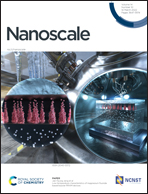Haloperoxidase-mimicking CeO2−x nanorods for the deactivation of human coronavirus OC43†
Abstract
Despite the excellent antibacterial and antifouling effects of haloperoxidase (HPO)-mimicking CeO2−x nanorods, their antiviral efficiency has not been explored. Herein, we designed and synthesized CeO2−x nanorods with varying aspect ratios via the hydrothermal method. CeO2−x nanorods catalysed the oxidative bromination of Br− and H2O2 to HOBr, the kinetics of which were studied systematically using a phenol red assay. The CeO2−x nanorods with the optimized aspect ratio (i.e., 4.5) demonstrated strong antiviral efficacies against the human coronavirus OC43, with no visible toxicity to the HCT-8 host cells.



 Please wait while we load your content...
Please wait while we load your content...
